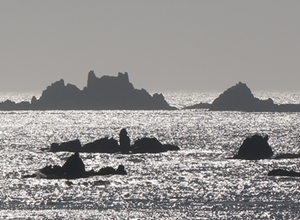Lyonesse
Was Scilly the inspiration for Tennyson’s Land of Lyonesse, the site of Arthur’s final battle with his rival Mordred?
“Then rose the King and moved his host by night,
And ever pushed Sir Mordred, league by league,
Back to the sunset bound of Lvonesse-
A land of old upheaven from the abyss.
By fire, to sink into the abyss again;
Where fragments of forgotten peoples dwelt,
And the long mountains ended in a coast
Of ever-shifting sand, and far away.
The phantom circle of a moaning sea.”

Mythology says that Lyonesse lay off the coast of Cornwall. The Seven Stones rocks have been called the last, lonely hilltops of a long-drowned world. Fifteenth and sixteenth-century writers insisted that there were 140 churches submerged between Cornwall and Scilly, and there are stories that fishermen would catch pieces of doors or windows in their nets and on their fishing hooks around Seven Stones Rock. In Mount’s Bay, near Penzance, the remains of a submerged forest can be seen at low tide.
A parallel fable exists in Brittany, where the drowned city of Ys, in the Bay of Douarnenez, is said to have church bells which still ring when the sea is rough. The story goes that Ys, like Lyonesse, was destroyed by a flood with only one survivor riding a white horse.
We do know that 15,000 years ago, the lands off the coast of Cornwall would have been above sea level, and the sea level around Scilly has risen about 4 meters in the last 3000 years, with the South West of the UK slowly sinking.
There are signs of field walls on the sea bed off Samson that can still be seen at low tide.
The Piper’s Hole Monster
At the top end of Tresco, north of Cromwell’s castle and facing Bryher, is a subterranean cavern called Piper’s Hole. This is said to communicate under the surrounding waves — a distance of about four miles – with the cave named Piper’s Hole on Penninis Head, St Mary’s.
There are stories of men having proceeded so far as to be seen no more; lost either through some intricacy in the unknown labyrinth — some frightful precipice over which they have fallen – some abyss of water, into which they have been plunged — or some unheard of monster by which they have been devoured. It was also said that dogs occasionally found their way through this passage, entering at St. Mary’s and emerging on Tresco alive but so scared that most of their hair had fallen out.
The cave is certainly said to be at least 80m deep at the Tresco end, and is believed to have been long-served by pirates and smugglers.
Rosevear
When the British East India Company packet ship Nancy was wrecked on the Gilstone Rock just off Rosevear on 24 February 1784, a few seamen managed to climb into the jollyboat, along with the famous opera singer Ann Cargill and her baby son. As they tried to make for relative safety on Rosevear itself they were wrecked on the treacherous ledges just beneath the water in front of it.
The jollyboat turned over and Ann, who rather than screaming was determinedly singing lullabies to her baby son, was trapped beneath and drowned. The rest of the jollyboat occupants were flung from it, and dashed to death on the rocks. It was three days before the gigs could get out to retrieve the bodies of those lost, and by then the rocks had done their worst – apart from to Ann. Her body, still wearing her white nightgown and still clutching her 18-month-old son, was found floating and intact. She was originally buried on Rosevear, but she and her son and John Haldane (the ship’s captain and the father of her child) were moved to Old Town Church on St Mary’s.
That might have been the end of it, but in the 1840s and 1850s the island was again inhabited by workmen building the Bishop Rock lighthouse the blacksmith was endlessly troubled by mysterious music – a flute, he thought, or perhaps a woman singing – and refused to spend the night there alone.
